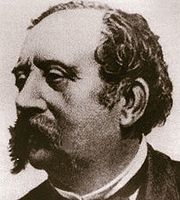
Charles Lasègue
Encyclopedia

University of Paris
The University of Paris was a university located in Paris, France and one of the earliest to be established in Europe. It was founded in the mid 12th century, and officially recognized as a university probably between 1160 and 1250...
, and during the following year was sent to Southern Russia by the French government to research an epidemic of cholera
Cholera
Cholera is an infection of the small intestine that is caused by the bacterium Vibrio cholerae. The main symptoms are profuse watery diarrhea and vomiting. Transmission occurs primarily by drinking or eating water or food that has been contaminated by the diarrhea of an infected person or the feces...
. Afterwards he was a physician at the Salpêtrière
Pitié-Salpêtrière Hospital
The Pitié-Salpêtrière Hospital is a teaching hospital located in Paris, France. Part of the Assistance publique - Hôpitaux de Paris, it is one of Europe's largest hospitals...
, Pitié and Necker hospitals. In 1869 he became professor of clinical medicine at Hôpital Necker, a position he maintained until his death in 1883.
Lasègue originally studied to become a philosopher, but changed to medicine when he was inspired by a lecture given by physician Armand Trousseau
Armand Trousseau
Armand Trousseau was a French internist. His contributions to medicine include Trousseau sign of malignancy, Trousseau sign of latent tetany, Trousseau-Lallemand bodies , and the truism, "use new drugs quickly, while they still work."-Biography:A native of Tours, Indre-et-Loire, Armand Trousseau...
(1801–1867). Lasègue later became an assistant and collaborator of Trousseau's, and was also his head clinician for a period of time during the 1850s. Lasègue published well over 100 works and 18 of them were co-written with Armand Trousseau.
Lasègue was versatile in many facets of medicine. In the 1860s he taught classes on nervous and mental illness
Mental illness
A mental disorder or mental illness is a psychological or behavioral pattern generally associated with subjective distress or disability that occurs in an individual, and which is not a part of normal development or culture. Such a disorder may consist of a combination of affective, behavioural,...
. He considered the disciplines of physiology
Physiology
Physiology is the science of the function of living systems. This includes how organisms, organ systems, organs, cells, and bio-molecules carry out the chemical or physical functions that exist in a living system. The highest honor awarded in physiology is the Nobel Prize in Physiology or...
and psychiatry
Psychiatry
Psychiatry is the medical specialty devoted to the study and treatment of mental disorders. These mental disorders include various affective, behavioural, cognitive and perceptual abnormalities...
to be complementary to each other, and was particularly interested in psychosomatic disorders. He described one of the earliest accounts of anorexia nervosa
Anorexia nervosa
Anorexia nervosa is an eating disorder characterized by refusal to maintain a healthy body weight and an obsessive fear of gaining weight. Although commonly called "anorexia", that term on its own denotes any symptomatic loss of appetite and is not strictly accurate...
, and also did research involving delusions of persecution.
As a psychiatrist Lasègue believed that by knowing a patient's history, the cause which created his or her mental imbalance could be found. He emphasized the role of parental attitudes and family interactions to be of supreme importance. With Jean-Pierre Falret
Jean-Pierre Falret
Jean-Pierre Falret was a French psychiatrist born in Marseille.In 1811 he began his medical studies in Paris, where he was inspired by the work of Philippe Pinel and Jean Étienne Dominique Esquirol...
(1794–1870), he introduced the concept "folie à deux
Folie à deux
-Further reading:*Halgin, R. & Whitbourne, S. Abnormal Psychology: Clinical Perspectives on Psychological Disorders. McGraw-Hill. ISBN 0072817216...
" to describe the coincidental appearance of psychotic symptoms in family members or closely associated persons while living together. This concept is sometimes referred to as the Lasègue-Falret syndrome.
Associated eponym
- Lasègue's sign: a sign often seen in sciaticaSciaticaSciatica is a set of symptoms including pain that may be caused by general compression or irritation of one of five spinal nerve roots that give rise to each sciatic nerve, or by compression or irritation of the left or right or both sciatic nerves. The pain is felt in the lower back, buttock, or...
or with lumbarLumbarIn tetrapod anatomy, lumbar is an adjective that means of or pertaining to the abdominal segment of the torso, between the diaphragm and the sacrum ...
disc problems. In sciatica, flexion of the hip is painful when the knee is extended, but pain-free when the knee is flexed.

